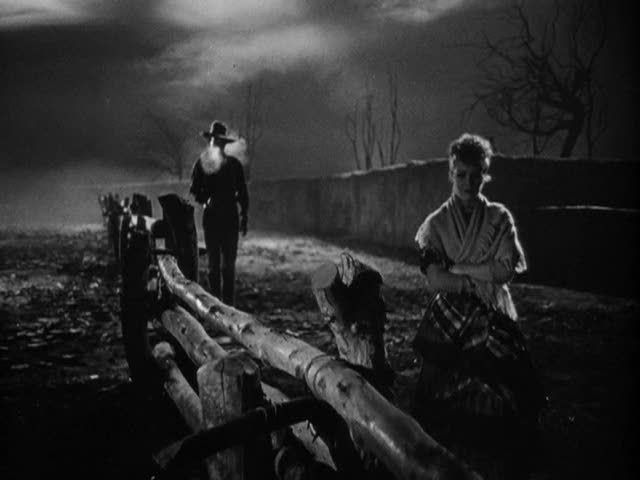
Stagecoach was the first film to unite director John Ford with both his iconic genre, the Western, and the actor who would come to be his most iconic star, John Wayne. Ford and Wayne both made Westerns before this, of course, but their collaboration on this film sparked something bold and unusual that would breathe new life into the genre and help shape it for the next two decades, the Golden Age of the Hollywood Western. It feels like something new and special is afoot from the moment Ford introduces Wayne as the wrongly jailed outlaw nicknamed the Ringo Kid. The harsh crack of a gunshot stops a speeding stagecoach, and Ford zooms in frantically from a long shot of Wayne to a tight closeup of his face, the ghost of a smile dancing around his lips, his hat brim curved above that chiseled, square-jawed visage. It feels like Ford knew, from the moment he introduced his star, just how strongly this image would resonate: Wayne's entrance into the film is electrifying, the arrival of both the infamous outlaw and the new upcoming star.
Despite this emphasis, the Ringo Kid is only one of the nine passengers who winds up aboard the eponymous stagecoach, all heading in the same direction, braving dangerous territory plagued by warring Apaches, for very different reasons. The lawman Curly (George Bancroft) aims to stop Ringo from triggering a bloodbath at the end of the line, where he knows the three men who killed Ringo's father and brother are waiting. The prostitute Dallas (Claire Trevor) and drunken doctor Boone (Thomas Mitchell) are being chased from town by the more "respectable" citizens, some of whom actually aren't as respectable as they'd like others to think. The suave gambler Hatfield (John Carradine) projects a gentlemanly image, but he might just be a cowardly killer, while the pompous Gatewood (Berton Churchill) is fleeing town with stolen payroll money. There's also the ill Lucy (Louise Platt), trying to reach her cavalry husband, the nervous whiskey salesman Peacock (Donald Meek), whose wares provide a temptation to Doc Boone, and the cracked-voice coach driver Buck (Andy Devine), who can't stop complaining about his Mexican wife and her seemingly endless supply of poor relations.
This motley crew is comprised of stock types, and the subtexts about social class and respectability are as broadly played as the humor: the other coach passengers are huffy and scornful of Dallas and Doc Boone, until they realize that both of these downtrodden people have much to offer in their generosity and compassion. Only Ringo, an outcast himself as an ex-con and a wanted outlaw, cares little about caste, and insists on referring to both Lucy and Dallas as "ladies," which of course earns Dallas' gratitude. The film's settings and characters are standards, familiar representations of the Old West, etched into the hard stone of the landscape: the wide expanses of dusty hardpan, the flat-top mesas and rocky abutments jutting up out of the ground. Ford draws with broad strokes, crafting iconic images of the stagecoach winding through the open country, kicking up a wake of dust behind it, the big dome of the sky overhead dotted with cotton fluffs of cloud. The film is painterly in its treatment of these Western vistas, which serve as a contrast to the more claustrophobic interior of the stagecoach, where Ford's compositions are necessarily simple in the cramped space.

Throughout the film, the threat of Indian attacks — and the inevitable showdown awaiting Ringo at the end of the line — looms over the stagecoach's journey, but it's mostly a slow-building tension until the climax. Things are relatively quiet for most of the ride, at least outside of the coach. The arguments among the passengers, largely motivated by class divides and various perceived slights, aren't nearly as interesting as the pictorial beauty of the surroundings. There's energy and poetry in Ford's exterior shots — a shadowy image of a silhouetted Ringo stepping up behind Dallas in the darkness, the countless shots of the coach speeding across the plains — even when nothing much is actually happening within the stagecoach. And of course the film's finale is exhilarating, with the Apache attack providing a perfect excuse for some fancy stuntwork, with jumps from one horse to another and daredevil leaps amidst the fray. The whole film was working towards this explosive action showcase, and one can't miss Ford's enthusiasm when, at the last minute, the cavalry rides in to save the day: a storied movie cliché that Ford invests with such vitality that it's hard to resist. The whole sequence is fun and fast-paced, and sets up Ringo's final shootout with the three brothers who killed his family and sent him to jail.
As one of the defining landmarks of the Western genre, the influence and importance of Stagecoach is hard to avoid. But it's far from a staid, outdated relic of its time, despite the extent to which its language and narrative devices have filtered down through the history of its genre ever since. The film's big cast of stock players is sometimes unwieldy, and its themes overly pat, but Ford's images project such grandeur, such a romantically beautiful image of the Western country and its heroes, that it's always obvious just why this film has remained so influential and well-loved.







0Awesome Comments!